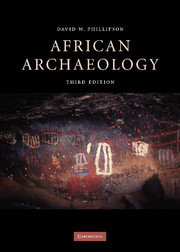Book contents
- Frontmatter
- Contents
- List of illustrations
- Sources of illustrations
- Preface
- 1 Introduction
- 2 The emergence of humankind in Africa
- 3 The consolidation of basic human culture
- 4 Regional diversification and specialisation
- 5 The beginnings of permanent settlement
- 6 Early farmers
- 7 Iron-using peoples before AD 1000
- 8 The second millennium ad in sub-Saharan Africa
- Bibliographic guide
- Bibliographic references
- Index
2 - The emergence of humankind in Africa
Published online by Cambridge University Press: 05 June 2012
- Frontmatter
- Contents
- List of illustrations
- Sources of illustrations
- Preface
- 1 Introduction
- 2 The emergence of humankind in Africa
- 3 The consolidation of basic human culture
- 4 Regional diversification and specialisation
- 5 The beginnings of permanent settlement
- 6 Early farmers
- 7 Iron-using peoples before AD 1000
- 8 The second millennium ad in sub-Saharan Africa
- Bibliographic guide
- Bibliographic references
- Index
Summary
Definition and process
Before attempting an account of the African evidence for human origins, it is fitting to make some general observations about the nature of that evidence and of the research on which it is based; it is necessary also to offer some definitions of the terms that are employed both here and in the writings of others. The first point that needs to be emphasised is that the evidence, although still very incomplete, is accumulating rapidly. New discoveries or analyses can frequently necessitate radical revision of our interpretations. However, there is often a long lapse of time between the initial announcement of a discovery (whether it be made in the field or in the laboratory) and its definitive publication. There are often strong political and financial pressures on researchers to make prompt – even premature – announcements. Indeed, a disconcertingly high proportion of the evidence on which the present synthesis is based comes from such preliminary accounts. Furthermore, very rarely is a truly continuous record available for study: we have a number of brief and incomplete glimpses separated by long intervals for which no information is available. Any attempt to reconstruct a continuous sequence must take account of this limitation.
Much of the ongoing research here described is being undertaken by collaborative teams of specialists. This chapter attempts to synthesise four main interlocking strands of evidence which are often the work of distinct experts: geology and faunal studies can yield information about habitat and chronology, examination of the hominid fossils has the potential to illustrate human physical evolution, genetic studies of both fossil and modern populations are beginning to make major contributions to knowledge of their inter-relationships, while associated artefacts and their associations elucidate some aspects of cultural development.
- Type
- Chapter
- Information
- African Archaeology , pp. 15 - 51Publisher: Cambridge University PressPrint publication year: 2005



